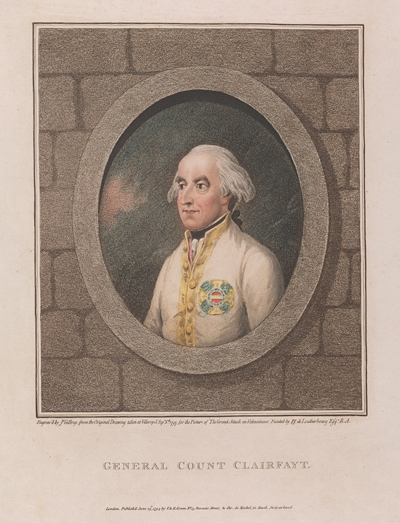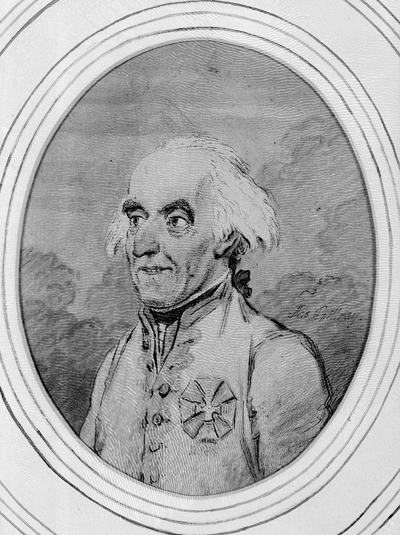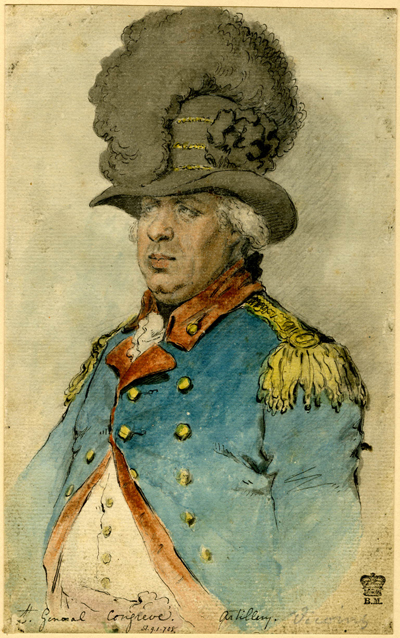General Count Clairfayt
In September 1793 when Gillray made the sketch that ultimately resulted in this print, General Count Clairfayt was a Field Marshal in the Austrian Army with a distinguished career of service in the Seven Years War, the Austro-Turkish wars, and most recently in the War of the First Coalition. It was then that he became a person of particular interest for Gillray's audience as an ally of Britain against revolutionary France, participating in significant victories with the Prince of Saxe-Coburg at Aldenhoven, Neerwinden, and with the Prince and the Duke of York at Valenciennes.

© Beinecke Rare Book and Manuscript Library, Yale University
After the commencement of the war with France in February 1793, there was naturally an interest to see images of the battles between the British and French (especially those that resulted in British victories) and portraits of the leaders of the combined forces from Britain and Austria who participated in those battles. So it is not surprising that after the victory at Valenciennes led by the young Duke of York in late July of 1793, the enterprising London publishers Valentin and Rupert Green along with the engraver/publisher Christian von Mechel in Basel would have commissioned a large scale painting commemorating the victory. The plan was to take advantage of the patriotic interest in the event in two ways: first to make money displaying a large scale painting of the battle to select audiences and then to make more money from the sale of prints based on the painting and the portraits created in preparing for it. This print is one of at least two such portraits created for this purpose. The other was of the Prince of Saxe-Coburg. But there may have been still more.
Philip James de Loutherbourg was selected to create the battle scene. A painter of dramatic landscapes, seascapes, and set designs for the Drury Lane Theatre, de Loutherbourg was probably a good choice to create a large-scale canvas with the requisite drama to attract interested patrons. Gillray was chosen to make preparatory sketches of the principal officers and the cannons, uniforms, pack horses, and other military equipment that would likely appear in a painting of the battle scene. He was no doubt selected because of his ability to make quick but accurate likenesses even under difficult conditions.
According to Draper Hill, Gillray set out for Valenciennes along with de Loutherbourg and Rupert Green on August 30, arriving in the area in September 3rd or 4th. Gillray is supposed to have visited the camp of General Count Clairfayt at Villerspol on September 6th and made his sketch of the Count the same day. Draper Hill seems to have assumed that the watercolor of General Count Clairfayt in the Museum of Fine Arts, Boston IS that sketch. But I think that is unlikely.

© Museum of Fine Arts Boston
The British Museum has a significant collection of drawings and watercolors created by Gillray while working with de Loutherbourg. None of them is signed and none of them looks anything like this. One need only compare the watercolor of Major (not General) Congreve (identified by the official key in the Description of the Print of the Grand Attack on Valenciennes) to see what Gillray would have provided to de Loutherbourg. The techniques could hardly be more different. The Boston watercolor is stiff, fussy, and seems to mimick the lines and cross-hatching of an engraving. Indeed I suspect that the watercolor was created not before but after the engraving by a hand other than Gillray's.

© Trustees of the British Museum
There are at least two states or versions of General Count Clairfayt. In the first state or version, the print is non-colored, the title is in italic, the portrait oval is flatter, and the wall behind the portrait oval is not bricked. In the second, presumably finished version, the print is colored, the title is in a regular, non-italic font, and the appearance of a raised portrait oval and a brick wall have been created with the use of aquatint.
The print of General Count Clairfayt was probably designed to appear coincidentally with the display of the Grand Attack on Valenciennes by de Loutherbourg. In any case, in June and July, 1794 there were ads in The St. James's Chronicle or British Evening Post and Lloyd's Evening Post announcing (among other subscription-related information) that
The Exhibition of the Picture, painted by Loutherbourg, representing the Grand Attack on Valenciennes, is now open on the Ground Floor, at the Historic Gallery, Pall-Mall. Admittance, One Shilling.
In this Picture, Portraits of twenty-six of the principal Officers of the Combined Armies are introduced, and an accurate View of the City of Valenciennes and its Fortifications, taken on the spot by Mr. Loutherbourg.
It would make sense that portraits of Clairfayt and the Prince of Saxe Coburg, both included in the Battle painting, and both with publication dates of June 23rd would have been on hand at the Gallery either for sale or as further incentives for subscribers to the Battle print.
Sources and Reading
- Commentary from the British Museum on General Count Clairfayt.
- "François Sébastien Charles Joseph de Croix, Count of Clerfayt," Wikipedia
- "War of the First Coalition," Wikipedia
- P. de Loutherbourg, The Grand Attack at Valenciennes
- Description of the Print of the Grand Attack on Valenciennes
Comments & Corrections
NOTE: Comments and/or corrections are always appreciated. To make that easier, I have included a form below that you can use. I promise never to share any of the info provided without your express permission.